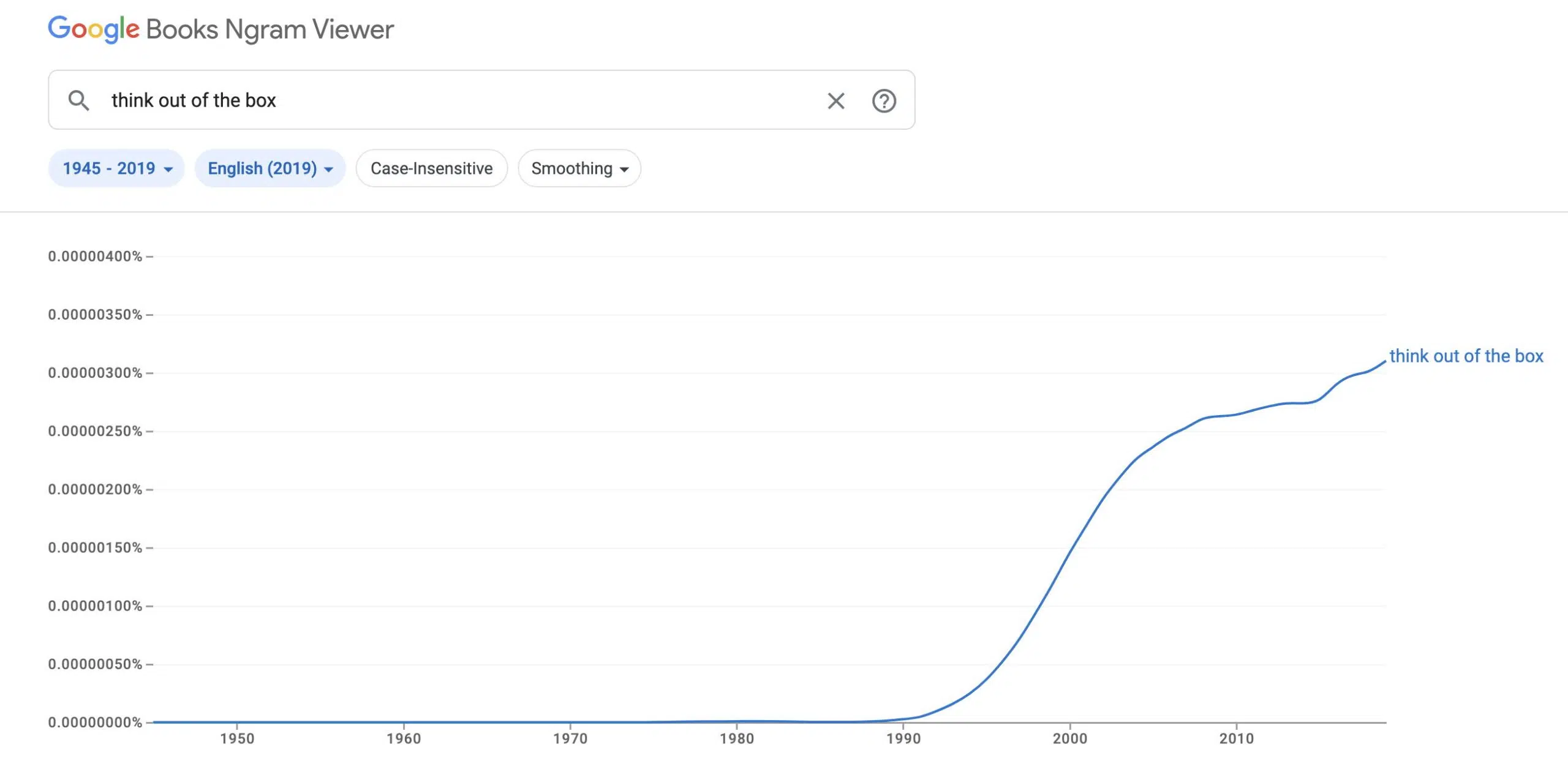
Introduction
The phrase “think outside the box” is often used as a call to creativity and innovation in design thinking. It suggests that we should let go of our preconceived notions and biases, and come up with new and unconventional ideas. But in order to truly think outside the box, we must first understand what that box represents.
To think out of the box
In this blog post, we’ll explore the importance of defining the box and the role of sensemaking and reframing in design thinking, and offer some strategies and techniques for encouraging outside-the-box thinking and innovation.
Thinking out of the box is a cognitive process that involves considering the limitations and constraints that may be shaping our perspective or our ability to think creatively. It often involves breaking free from preconceived notions or assumptions, and looking at a problem or challenge from a different angle.
One way to think about the box is to consider the mental models or paradigms that we use to make sense of the world around us. These mental models can be helpful in organizing and processing information, but they can also limit our ability to see things in a new way. By questioning and challenging these mental models, we can expand our thinking and come up with new and innovative ideas.
Define the box
Defining the box, or the set of constraints and assumptions that limit our thinking, is an essential first step in the process of breaking free from it. Without a clear understanding of what we’re working within, it’s difficult to know where the boundaries are, or how to push beyond them.
Another way to think about the box is to consider the social and cultural context in which we exist. Our social position, as defined by our social identities and characteristics, can shape the way we perceive and understand the world. By recognizing and challenging the biases and assumptions associated with our social position, we can broaden our perspective and think more creatively.
In design thinking, this process is often known as sensemaking – the act of making sense of complex or ambiguous situations, and identifying patterns and trends that can inform our thinking. Part of sensemaking is defining the box, or the set of constraints and assumptions that limit our thinking.
But sensemaking is about more than just exploring limits. It’s also about identifying opportunities for creative problem-solving, and finding ways to challenge and reframe the assumptions that might be holding us back. This process of reframing involves looking at a problem from a different perspective, and considering new and innovative approaches that might not have been immediately obvious.
In practice
In this list, we’ll explore a range of methods and principles for defining the box and encouraging outside-the-box thinking.
Methods
- The first step is to clearly define the challenge or request you are trying to address. This involves translating the brief into a design language and rephrasing the problem as a design challenge. By moving away from the preconceived notion that the solution must be a product or a service, you can open up new possibilities and approaches to solving the problem.
- Empathise: By actively listening to and observing the people we are helping, we can gain a deeper understanding of their experiences, values, and motivations, and identify the underlying assumptions and constraints that might be shaping their behaviours and choices. This can help us develop more meaningful and relevant insights and solutions.
- Consider the context: Understanding the broader context in which a problem or challenge exists can help us identify the constraints and assumptions that might be influencing our thinking.
- Seek out diverse perspectives: Seeking out input from people with diverse backgrounds and expertise can help us identify new and innovative approaches, and challenge the assumptions and constraints that might be limiting our thinking.
- Evaluate the evidence: Use critical thinking skills to carefully evaluate the evidence and arguments related to the problem. This may involve questioning assumptions, examining the reliability of sources, and considering different lenses of explanations.
- Sleep on it: Research has shown that sleep can play a role in the process of problem-solving and decision-making. During sleep, the brain is able to consolidate and process information, and this can help to facilitate insight and creativity.
- Use visualisation and mind mapping: Visualisation and mind mapping can be useful tools for thinking out of the box. They can help you brainstorm and explore different ideas and connections.
Approach and mindset
- Encourage divergent thinking: Allowing ourselves to generate a wide range of ideas and perspectives, and not immediately judging or dismissing them, can help us identify the assumptions and constraints that might be limiting our thinking.
- Embrace ambiguity: Embracing ambiguity and uncertainty can help us open ourselves up to new and innovative ideas, and identify the assumptions and constraints that might be limiting our thinking.
- Embrace feedback: By remaining open to feedback and being willing to revise and iterate on our ideas, we can identify and challenge the factors that might be shaping our thinking
- Keep an open mind: Remaining open to new and unexpected ideas, and not immediately dismissing them, can help us identify the assumptions and constraints that might be limiting our thinking.
- Recognisse and challenge cognitive biases: Cognitive biases are mental shortcuts that can lead us to make judgments that are not based on objective evidence. When reframing a problem, it’s important to recognise and challenge these biases, as they can prevent us from seeing the issue clearly and considering all the options.
- Continuously reassess and adapt: Reframing is an ongoing process, and it’s important to continuously reassess and adapt your approach as new information becomes available or circumstances change. Don’t be afraid to make adjustments or pivot to a new solution if it becomes clear that your current approach isn’t working.
Thinking outside of the box
Thinking outside of the box is a valuable skill that allows us to come up with creative solutions to problems and challenges. However, in order to truly think outside of the box, we must first define and understand the “box” that is constraining our thinking. This involves identifying the assumptions and constraints that are limiting our perspective and influencing our decision-making. By surfacing these underlying factors, we can start to question and challenge them, and begin to expand our thinking beyond the confines of the “box.”
Designers, in particular, can benefit from this approach by using the principles and advice outlined in the article to guide their thinking and problem-solving. By adopting a mindset of curiosity and openness, and by actively seeking out diverse perspectives and challenges, designers can push the boundaries of what is possible and come up with innovative solutions that truly stand out.
In conclusion, the key to thinking outside of the box is to first define and understand the “box” that is constraining our thinking, and then to critically seek out ways to challenge and overcome those constraints. By doing so, we can open ourselves up to new ideas and possibilities, and create more meaningful and impactful solutions.
Appendix: a post-Cold War expression

Source: Ngarm Viewer – The Google Ngram Viewer is a tool that allows users to search and analyze the frequency of words and phrases in a large database of books.
It is difficult to say exactly why the phrase “think out of the box” appears to have grown in popularity after the end of the Cold War, as there are likely a number of factors at play.
One possible explanation is that the end of the Cold War marked a significant shift in global politics and economic systems, and this shift may have led to a greater emphasis on innovation and creative thinking as businesses and organizations sought to adapt to new realities. In this context, the phrase “think out of the box” may have gained popularity as a way to encourage people to embrace new ideas and approaches and to challenge conventional wisdom.
The phrase “think outside the box” is also often associated with the “nine dots” puzzle, which is a problem that requires people to think creatively in order to find a solution. The puzzle which started to grow in popularity during the 80s consists of nine dots arranged in a three-by-three grid, and the goal is to draw four straight lines that connect all of the dots without lifting the pen from the paper. Then the participants would be required to connect the dots using only three, requiring to play with the problem creatively.
Overall, it is likely that a combination of these and other factors contributed to the growth in popularity of the phrase “think out of the box” after the end of the Cold War.